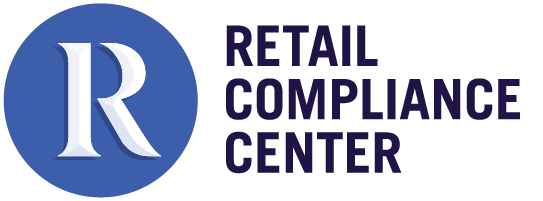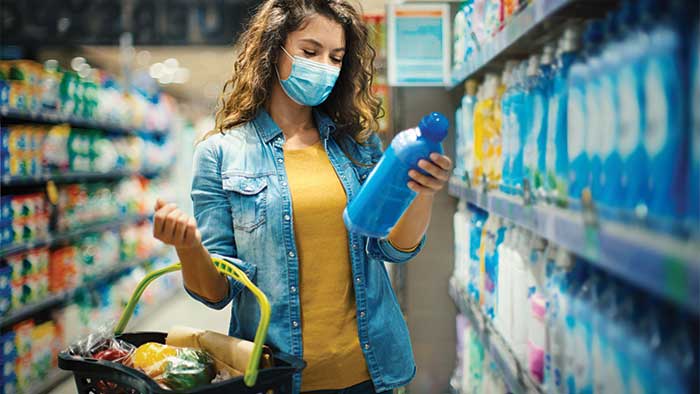Consumer Products
Consumer Products (Cleaning, Chemicals, Health & Beauty)
This area covers the sale of consumer or commercial products not included in the more specialized departments, and includes cleaning products, chemicals, and health and beauty products. Environmental issues related to products used internally for maintenance is covered in the RCC Store Operations Department page. The main environmental compliance issues associated with this department are hazardous materials, hazardous waste, and environmental standards for products.
In the store, cleaning, and health and beauty aisles may be separate, but from an environmental regulatory standpoint, these products share many of the same regulations. This is why they are covered together on this page.
COMPLIANCE CONSIDERATIONS
Many retail consumer products, including products in the cleaning, and health and beauty categories, may need to be handled as hazardous waste when returned, expired, recalled, or damaged. Improper disposal of hazardous products, such as pouring them down the drain, onto the ground, into storm drains, or putting them into the trash, can be potentially dangerous and against the law. State laws can differ from federal requirements, so it is important to always check state laws.
Determining if a Product May Be a Hazardous Waste

Before disposing of products or shipping them to a return center, it is critical to determine which items might be considered hazardous waste. This is important for cleaning or chemical products, as well as for many products from the health and beauty aisle. Federal and state hazardous waste regulations outline a process for hazardous waste determination and have strict rules for handling hazardous waste. The RCC Hazardous Waste page provides more detail on these requirements.
The consequences of improper waste determination can be severe from environmental, health, and safety, as well as legal, perspectives. If in doubt, it may be prudent to assume an item is hazardous waste. Sometimes the product labeling gives an indication that a product may be hazardous. For example, there is a significant chance that cleaning products and chemicals with package labeling that contains signal words like "Danger," "Poison," "Toxic," "Corrosive," or "Flammable" may be hazardous wastes (although this will not always be the case). Words such as "Warning" or "Caution" indicate the product poses some degree of risk and therefore might also be a hazardous waste. Retailers should evaluate these products more closely or may wish to simply assume they will be hazardous wastes when disposed.
The following types of household cleaners are in many instances classified as hazardous wastes when disposed:
- Furniture polish
- Drain cleaner
- Oven cleaner
- Tub and tile cleaner
- Toilet bowl cleaner
- Carpet and upholstery cleaners or spot removers
- Bleach
- Disinfectants
- Ammonia, possibly including some glass cleaners
- Air fresheners
Other consumer products that frequently must be managed as hazardous wastes include:
- Oil based paints
- Spray paints
- Paint thinners and mineral spirits
- Paint strippers
- Pool chemicals
- Aerosol spray cans
Health and beauty products that may be considered hazardous waste include:
- Aftershaves and fragrances
- Hairspray
- Aerosol deodorant
- Nail polish and nail polish remover
- Hair dyes
- Hair removal creams
- Suntan lotion
- Many cosmetics
This is not a comprehensive list and individual products must be evaluated separately. Some states have more stringent rules for what is considered a hazardous waste. Retailers often work with consultants or waste haulers to ensure that they correctly identify all products that could be hazardous wastes.
Personal Care Products

The EPA defines Pharmaceuticals and Personal Care Products ("PPCPs") as "any product[s] used by individuals for personal health or cosmetic reasons … including … fragrances, lotions, and cosmetics." This category includes prescription and over the counter drugs, which are covered in the RCC Pharmacy page. Non-pharmaceutical PPCPs (i.e., personal care products) are addressed here.
The disposal of personal care products is regulated by multiple agencies, including: EPA, state environmental agencies, local governments, and potentially local Publicly Owned Treatment Works (POTWs).
Both hazardous and non-hazardous personal care products generally should not be disposed of down sinks or drains as wastewater treatment plants may not be equipped to remove these chemicals from wastewater and they are potentially harmful to the environment. Under the Clean Water Act, local POTWs have the authority to set local limits for pollutants that are allowed in their system, and any material poured down a drain must comply with these limits. The RCC Water Page has more information on disposal in wastewater.
Environmental Standards
VOC Emission Standards – The EPA, and some state and local jurisdictions, have limits on the amount of volatile organic compounds (VOCs) contained in certain products sold at retail stores. These standards may apply to cleaning products and chemicals (such as disinfectants, floor polish, paint thinner, and glass cleaner) and beauty products (such as hair spray, nail polish remover, and shaving cream).
State Toxic Chemical Management – Under California's Proposition 65, or the Safe Drinking Water and Toxic Enforcement Act, companies who have products that may expose consumers to a chemical on the Prop 65 list must provide a warning to consumers. Other states may have similar regulations.
The RCC Product Compliance and Toxics page has more information on these environmental standards.
Hazardous Materials Transportation
The Hazardous Materials Regulations (HMR) are rules issued by the Department of Transportation's Pipeline and Hazardous Materials Safety Administration (PHMSA) for shipping products that are considered hazardous materials. These materials include, but are not limited to, items that are explosive, flammable, radioactive, corrosive, water reactive, gaseous, or poisonous (plus a miscellaneous category). The regulations define requirements for classification, packaging, hazard communication, security, incident reporting, handling, and transportation. All employees who are involved in the transport of hazardous materials (including loading and unloading) must have training every three years.
The RCC Hazardous Materials Transportation page has more information.
SUSTAINABILITY
Retail facilities may be able to reduce compliance, disposal costs, and regulatory risk by promoting or offering fewer products that have the potential to become hazardous wastes. In some cases, very similar products can have different regulatory liabilities and costs with one product having the potential to be considered a hazardous waste while the other is not.
There is a push to replace cleaning products and chemicals with less hazardous versions. The EPA's Safer Choice program (formerly Design for the Environment) identifies products that may be less hazardous. Standards addressing other environmental or related attributes include Green Seal, USDA Organic, and USDA Biopreferred products. Selling products that are less hazardous or have other favorable environmental or related attributes can also enhance a company's brand.
Related Content
Product Stewardship & EPR Matrix
Summary of state product bans, EPR and product stewardship legislation for packaging and products such as carpet, batteries, electronics, paint and more.
Product Compliance
Regulations at the product level that cover chemicals in products, labeling and disclosure requirements, pesticides and performance standards.
Hazardous Waste Variations by State Matrix
Overview of state variations in hazardous waste regulations under RCRA, including hazardous waste characteristics, thresholds, and universal waste.
Product Compliance and Toxins Regulations
Regulations such as FIRFA, TSCA, state chemical regulations, and VOC standards that apply to certain retail products.
Tags
-
Chemical Ingredients and Labeling
-
Hazardous Waste
-
Haz Mat Transportation



